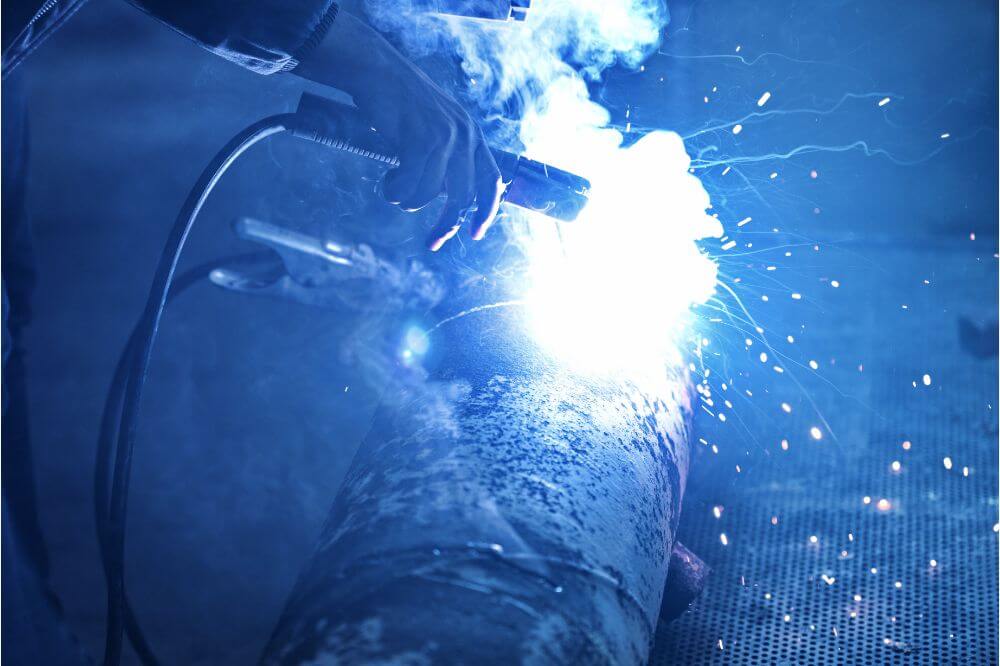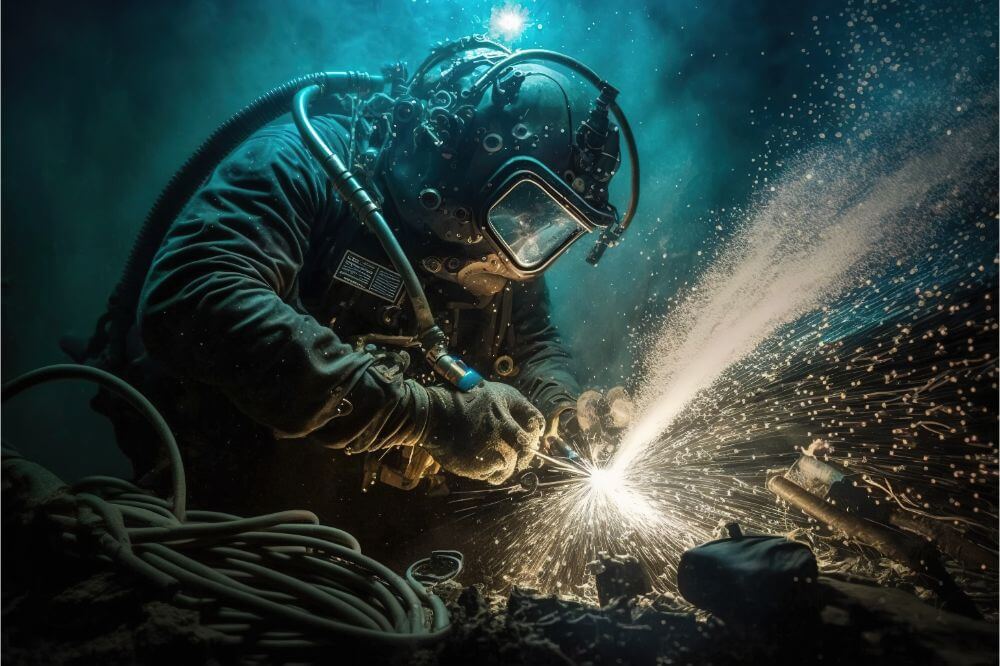Underwater welding is a specialized skill combining technical knowledge in welding and diving. This fascinating field is crucial in maintaining and repairing underwater structures like pipelines, ships, and offshore platforms.
There are three main types of underwater welding techniques: wet welding, dry welding, and hyperbaric welding, each offering unique advantages and disadvantages.
This article dives deep into these techniques, providing insights into the equipment, pros, cons, and safety concerns associated.
Wet Welding
Wet welding is performed directly in the water, with the welder-diver using a waterproof electrode and a specially designed welding machine.
This cost-effective and versatile method allows for quick repairs and maintenance of underwater structures. However, the quality of wet welds may be lower due to the presence of water and the potential for hydrogen embrittlement.
Equipment and Setup
In wet welding, the equipment needed includes a waterproof electrode holder, specialized waterproof electrodes, and a power source with a direct current (DC) output.
The diver must also wear appropriate personal protective equipment (PPE), such as a diving helmet with an integrated welding shield and a dry or wet diving suit.
The power source and welding cables are housed above the water on a support vessel or platform.
During the wet welding, the power source sends the electrical current to the electrode holder and then through the welding rod, creating an electric arc that melts the metal base and electrode simultaneously.
Advantages
Wet welding offers several advantages, one of which is its cost-effectiveness. As it requires less specialized equipment and a simpler setup, executing projects with wet welding will generally be cheaper than alternatives, saving clients money and making it attractive for some applications.
Additionally, it allows for faster job completion, given its higher mobility and adaptability in different underwater environments. The welder can perform tasks in difficult-to-reach areas without extra support, saving time and minimizing interruptions.
Lastly, the versatility of wet welding makes it suitable for various underwater structures like pipelines, ship hulls, and offshore platforms, including on-site repairs and maintenance.
Disadvantages
While wet welding has its advantages, it also has some drawbacks. For one, the quality of welds produced is generally lower than in other underwater welding techniques. This is primarily due to exposure to water, which can cause rapid cooling, porosity, and loss of strength in the weld.
Furthermore, wet welding can be hazardous for the welder-diver. Alongside the typical risks associated with diving, the combination of water and electricity increases the risk of shock or electrocution.
Finally, the visibility in wet welding can be poor, making it difficult for the welder-diver to produce accurate and consistent welds.

Dry Welding
In contrast to wet welding, dry welding occurs inside a sealed chamber, which is positioned around the structure being welded.
The chamber is filled with a gas, typically a mix of helium and oxygen, creating a dry environment that allows welders to use conventional welding equipment. This method offers improved weld quality and fewer safety concerns than wet welding.
Equipment and Setup
The welding chamber is sealed around the area to be welded in dry welding, creating a dry environment within which the welder can work. Specialized equipment, such as a habitat or a flexible welding chamber, is necessary. Wet welding has fewer safety risks since the welder isn’t exposed to water.
A surface-supplied diving system typically provides the welder with breathing air and communication links to the surface.
Unlike wet welding, dry welding usually requires more equipment and setup time. However, it offers improved weld quality and is ideal for critical structural repairs.
Advantages
Dry welding offers some critical advantages over other underwater welding techniques. It provides better weld quality, created in a dry environment without water interference.
Ultimately, this leads to a stronger and more durable weld. Additionally, dry welding can be performed at greater depths than wet welding, addressing the challenges of high water pressure.
Another advantage is that it requires less post-weld processing, such as grinding or polishing, which can save precious time and resources.
Disadvantages
However, dry welding has its disadvantages as well. The need for specialized habitats or chambers can make this process more expensive and time-consuming than wet welding, as equipment setup and removal can take longer.
Moreover, since the technique can only be performed in shallow depths, it may not be suitable for all underwater projects, especially those at greater depths.
Lastly, dry welding has a limited working area, which might slow the overall project and reduce efficiency. Their advantages could outweigh these downsides when high-quality welds are crucial.
Hyperbaric Welding
Hyperbaric welding occurs in a chamber filled with a pressurized gas mixture, providing a dry environment at depth. This method utilizes specialized equipment, including a hyperbaric chamber and a closed-circuit monitor.
Advantages include improved weld quality and dive safety, but the high costs and logistical challenges can deter many projects.
Equipment and Setup
In hyperbaric welding, divers work within a dry, pressurized chamber known as a habitat. The habitat is attached to the underwater structure where the weld needs to be performed. Entry and exit points allow divers to move between the habitat and the water.
Divers perform welds using standard welding equipment, typically TIG or MIG welding, while the chamber maintains a dry environment.
Compressed gas, usually helium or nitrogen, is used to pressurize the habitat, and a gas management system is required to remove any harmful fumes emitted during the welding process.
Advantages
One of the main advantages of hyperbaric welding, which sets it apart from other underwater welding methods, is the ability to produce high-quality welds comparable to those made on the surface. This is possible as the process occurs in a pressurized environment, allowing for better control over the welding parameters and reduced chances of shielding gas contamination.
Furthermore, hyperbaric welding enables divers to work at greater depths, making it a preferred option for deep-sea projects.
Lastly, in some cases, hyperbaric welding can offer faster completion times, as the welders can work in a more controlled environment with easier access to tools and equipment.
Disadvantages
Although hyperbaric welding offers several advantages, it also has its drawbacks. One significant disadvantage of this method is the high cost of setting up the hyperbaric chamber. This makes it unsuitable for smaller jobs or projects with tight budgets.
Moreover, the complexity of the hyperbaric welding process requires specialized skills, which may not be readily available. Additionally, working in a pressurized environment for long periods can adversely affect the welder-diver’s health.
Lastly, due to the enclosed nature of this process, it may be unsuitable for specific underwater locations or structures with limited accessibility.
Comparison of Techniques
In comparing these techniques, wet welding is the fastest and most cost-effective, but it produces weaker welds. Dry welding generates strong welds but requires more elaborate setups. Hyperbaric welding is the best for creating high-quality welds but is costlier and more time-consuming.
Choosing a technique
depends on the specific project’s requirements and priorities.
Wet Welding vs Dry Welding
When comparing wet and dry welding, the primary distinctions lie in the welding environment and the quality of the final product. Wet welding involves a diver performing the weld underwater in direct contact with the water, while dry welding isolates the area to create a dry environment.
Consequently, dry welding offers superior weld quality, less susceptibility to defects, and enhanced safety, but it requires more complex equipment and can be time-consuming and costlier.
Wet welding, conversely, is more straightforward and cost-effective but has limitations regarding weld quality and diver safety.
Wet Welding vs Hyperbaric Welding
When comparing wet welding and hyperbaric welding, several factors come into play. Wet welding is significantly cheaper and requires less specialized equipment. However, the weld quality may be lower due to the potential for rapid cooling or contamination.
On the other hand, hyperbaric welding offers superior weld quality. It allows divers to work in greater comfort, but it is more expensive and time-consuming due to the need to construct a dry environment around the work area.
Dry Welding vs Hyperbaric Welding
When comparing dry welding and hyperbaric welding, the main difference is where the welding occurs. Dry welding is performed in a sealed chamber with the work area and surrounding air expelled, while hyperbaric welding occurs underwater in a pressurized environment.
Hyperbaric welding provides higher-quality welds and minimizes the risk of water contamination, but it’s more complex and requires specialized equipment. On the other hand, dry welding is relatively easier to set up and more cost-effective for specific projects.
Safety Concerns and Precautions
Despite the valuable contributions of underwater welding, addressing safety concerns and precautions are essential. Diver safety is paramount, with strict adherence to guidelines and proper training minimizing risks.
Furthermore, being mindful of the environmental impact ensures the preservation of aquatic ecosystems, employing best practices to limit potential adverse effects.
Diver Safety
Diver safety is a critical topic when discussing the types of underwater welding. Divers must be well-trained and experienced before welding underwater, as the risks can be significant.
Divers should always adhere to strict safety protocols, such as buddy checks, monitoring air supply, and frequent communication with the surface team. In addition, they must ensure that all equipment, including welding machinery, is properly maintained and functioning as intended.
Furthermore, divers should be prepared for emergencies, such as equipment malfunctions or sudden shifts in environmental conditions, to minimize the chances of accidents or injuries during welding procedures.
Environmental Impact
When it comes to the environmental impact of underwater welding, there are a few things to consider. One concern is the release of pollutants generated during the welding process, such as metal and slag particles, into the surrounding water bodies.
These contaminants can harm aquatic life and negatively affect the underwater ecosystem. Proper containment and collection methods are used for debris and waste materials generated during the process.
In addition, the sound produced during underwater welding can affect marine life, as many underwater species rely on sound for communication and navigation. Underwater welders must follow guidelines and regulations to minimize the detrimental impact on the environment.
Conclusion
Underwater welding is an essential field with various methods, each with advantages and disadvantages. Professionals must understand these techniques, equipment setups, and safety concerns to efficiently and effectively work on underwater projects.

